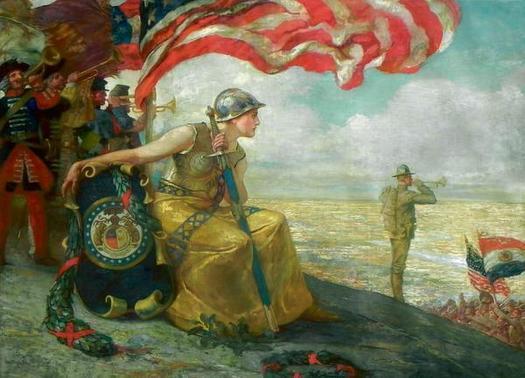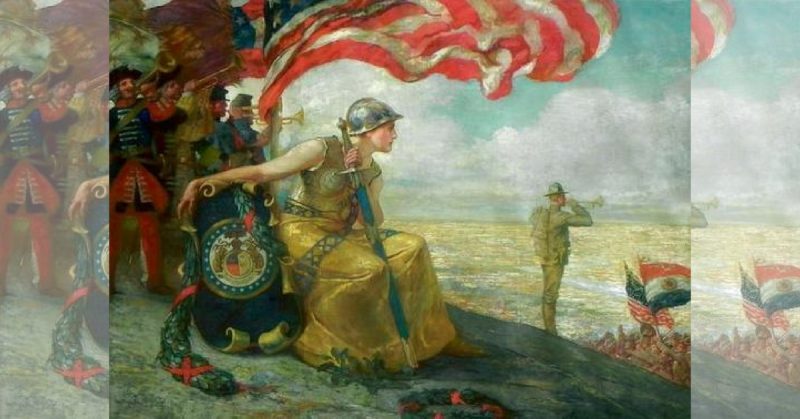War History online proudly presents this Guest Piece from Jeremy P. Ämick, who is a military historian and writes on behalf of the Silver Star Families of America.
Edwin Howland Blashfield possessed many talents and abilities, the most notable of which involved his creation of various murals that adorn the interior of state capitols and associated buildings throughout the United States. With a keen eye for both historic grandeur and symbolism, it is of little surprise that his reputation drew an interest from the Kansas City Chapter of the Daughters of the American Revolution (DAR) during World War I.
A native of New York, the February 13, 1917, edition of the Kansas City Times reported that Blashfield visited “Kansas City to consider plans for murals here.”
In her book aptly titled “Edwin Howland Blashfield: Master American Muralist,” Mina Rieur Weiner wrote that Blashfield, an “exemplar and advocate of classic tradition in America, rose to prominence as a muralist during the 1893 World’s Columbian Exposition in Chicago and the 1917 United States entry into World War I.”
At the time of his visit to Kansas City, the artist had already begun documenting on canvas the war that embroiled much of Europe, having recently completed the painting referred to as “Sisters of Liberty,” which “allegorically represented America, France, and Russia, the greatest Democratic nations of the world, all of whom shed their blood for freedom,” reported the St. Louis Post-Dispatch on May 6, 1917.
The Kansas City Chapter of the DAR soon commissioned the artist to paint a mural in honor the citizens of Missouri who answered the nation’s call to arms in the First World War. The result was a painting that measured 79-1/2 inches by 108 inches and, as described by the New York Times on June 16, 1918, served as a “historical outline of the development of the State.”
The foreground features a woman symbolizing Missouri, seated and clad in armor while watching her sons depart for war. Further historical symbolism emerges with a group of trumpeters in the background, “representing Old France, Old Spain, and the Union and Confederate forces, while in the front of her is a figure in khaki representing the Union of the present time, sounding the call to arms,” the New York Times further clarified.
“The idea that we should commemorate on canvas the veterans of World War I was really part of a larger cultural discourse of that period,” said Derrick Cartwright, associate professor of art history and director of galleries for the University of San Diego.

“In the early 1990s,” Cartwright added, “I was writing my doctoral dissertation on murals in public libraries and that’s when I discovered the Blashfield painting was one such mural that had essentially gone missing.”
The 32nd Annual Report of the National Society of the Daughters of the Amerian Revolution (printed in 1920) stated that Blashfield’s “Call of Missouri” was commissioned by the Kansas City Chapter of the DAR at a cost of $20,000.
Following its completion in 1918, the artwork was briefly displayed at an art gallery in Blashfield’s home state of New York, but later that year was presented by the DAR as a gift to the Kansas City Public Library to be hung in its facility at Ninth and Locust Streets.
For decades, the Blashfield painting adorned a wall above a grand fireplace mantel in the library building; however, David Disney, a senior vice-president of a major Kansas City area construction company who has been tracking the painting’s whereabouts, noted its initial disappearance from the Kansas City area.
“The library building was purchased by U.S. Trade School and the painting was in there when it was purchased, but it disappeared sometime in the 1980s,” Disney said. “No one really knows what happened to it and the trade school has since closed and the building is now home to Ozark National Life,” he added.
Disney explained that he has invested countless hours searching for Blashfield’s masterpiece, and his research most recently led him to an art dealer in Dallas, who was selling the painting for a customer. However, the painting again went absent when it was sold to an anonymous collector at an auction.
According to the website for the auction service of Christie’s New York, the Blashfield painting, which they referred to as “Trumpets of Missouri,” was sold at auction in 2014 to a private bidder for a substantial $149,000.
More than three decades have passed since the “Call of Missouri” first departed from its Kansas City home and although it was later discovered, it has again managed to slip from the public eye. Disney, however, remains hopeful that this World War I work of art will some day be returned to the state for which it was created to honor.
“The painting has always been important to me personally because the first time that I saw a picture of it, I realized the commitment that was made by the people of Missouri to go and fight the battles of World War I,” Disney said. “It was one of those pieces that once you view it, you never forget it.”
Pausing, he concluded, “And, it is my personal opinion that this piece is still the property of the Daughters of the American Revolution here in Missouri and I can only hope that it will someday be returned to the people of Kansas City.”
